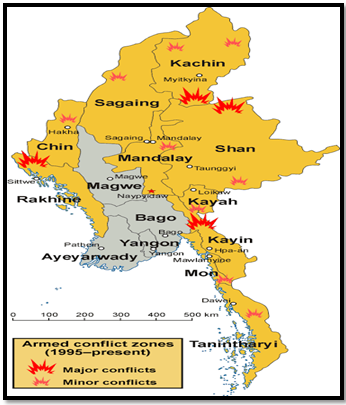MYANMAR’S ARMED CONFLICT AND REGIONAL DYNAMICS
Why in the News?
- The Myanmar military’s 2021 coup has led to significant political upheaval, with resistance movements gaining strength against the military regime.
- Ethnic Armed Organizations (EAOs) and groups like the People’s Defence Forces (PDFs) have made considerable territorial gains, challenging the military’s control and highlighting the need for a new political framework based on federalism and democracy.
Source: Researchgate
The Military Coup and Its Aftermath
- The 2021 coup by the Myanmar military removed civilian leaders like Aung San Suu Kyi, leading to persistent violent resistance.
- The military’s indiscriminate use of force has eroded its legitimacy, resulting in the loss of control over large parts of the country to EAOs and PDFs.
Territorial Gains by EAOs
- The Brotherhood Alliance, including the Arakan Army and other groups, has made significant territorial advances, capturing key towns and military posts.
- The Arakan Army has gained control of large areas in the Rakhine province and strategic locations along the Bay of Bengal, impacting regional projects like China’s Belt and Road Initiative and India’s Kaladan project.
China’s Influence and Strategic Interests
- China has engaged with both the Myanmar military and various EAOs, balancing its economic interests and security concerns.
- Despite supporting ceasefires, China has also supplied military equipment to both the military and EAOs, maintaining leverage in Myanmar’s fragmented sovereignty.
India’s Role and Potential Contributions
- India can offer its federalism expertise, financial frameworks, and peace agreements like the Mizoram Peace Accord to help stabilize Myanmar.
- India’s successful infrastructure projects in conflict zones, like Afghanistan, suggest it can contribute significantly to regional peace and development in Myanmar.
- India can facilitate dialogue among Myanmar’s stakeholders, drawing from its experience in conflict resolution and fostering democratic institutions.
Myanmar’s Geography
Associated Article: https://universalinstitutions.com/the-myanmar-conflict-is-a-regional-problem/ |





